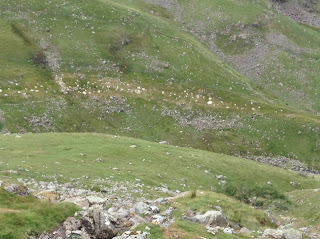A kit from the supermarket gave me my first introduction to spherification. The process makes the little jelly spheres that I used to decorate the cakes. The pictures show the process in reverse.
This is what they looked like after being rinsed. I'm not the only person thinking of fish roe.
The brown bowl contained a solution of calcium chloride.
I was given a green and an orange solution that contained sodium alginate from seaweed. On adding drops of the sodium alginate mixture into the calcium solution, gel spheres formed. They mostly sank to the bottom but floated if they contained too much air.
As far as I can ascertain, the alginate forms a type of chain polymer and the calcium ions allow cross-links to form between chains to give it some structure. The picture in the kit shows alginate chains arranged in a circle which will presumably be dictated by the surface tension of the drop. Then calcium ions sit on this surface and cross-link it to an outer sphere of alginate chains. There are good food chemistry posts about it all
here and
here.





























